Not everybody knows that using rubrics in education can significantly benefit students. The Ivypanda.com team decided to craft this guide to familiarize you with this fantastic approach. Rubrics can make it far easier to meet your professors’ expectations and complete assigned tasks.

Once you master all the aspects of this tool, you will manage your college workload seamlessly. So, what are you waiting for? Hurry up and read all about using rubrics to achieve your full potential.
✨ The Importance of Rubrics
Below, we’ll explain the nature of rubrics and why they’re so advisable for studying. You may use them to plan, self-assess, perform tasks, and multitask efficiently. But first, let’s talk about the definition of a rubric.
Essentially, a rubric is an evaluation tool for academic assignments. Educators use it to score work in an unbiased and transparent fashion.

You can apply rubrics both for evaluating assignments and providing feedback. The same method can be used for essays, research papers, group projects, oral presentations, and other academic tasks.
How Does the Rubric Help Students?
A rubric is a versatile tool that has a considerable impact on a student’s academic progress. You can use this matrix as a cheat code. We’ll explain exactly how it can enhance your learning process.
Check out the rubrics’ benefits:
- They leave nothing to chance. You can clearly understand how the work should be carried out. After getting an assignment back, students are probably going to see which areas need to be improved.
- They encourage a more positive learning experience. Rubrics push students to uncover their positive and negative attributes. They are less prone to find blame in others and more likely to see their level of performance clearly.
- They assist students in evaluating their own work. This tool makes it easier for students to look at their assignments with a clear mind. It also allows them to better evaluate the work of their peers.
- They help students avoid comparing themselves to others. Sometimes, students can feel inadequate about their work. They can track their progress with rubrics instead of measuring it against others.
- Rubrics give students timely feedback. Students might fail to understand why they received a bad grade in college. They may get vague responses or no feedback at all. With rubrics, educators can quickly explain the reasoning behind their scores.
📝 The 8 Types of Rubrics
Check out the eight types of rubrics to choose the most suitable one for you. We’ll cover each of them in great detail below. Also, you can find information on how to create and use them effectively.
Developmental Rubric
This type is a subdivision of the analytical rubric. The main difference from other rubrics is that it doesn’t evaluate performance or the end product. The developmental method is more interested in the level of engagement students show towards evolving skills, abilities, programs, values, and others.
For example, this rubric can be used to assess how well a student’s interpersonal or cognitive skills are growing. Perhaps it’s difficult for them to explore other points of view, or maybe they refuse to change their beliefs. Educators can also use this rubric to see how well their pupils interact with people from different cultures and social backgrounds.
As such, developmental rubrics evaluate the progress made by students instead of the content of their work. They are also used to see how students can adapt to new information and facts.
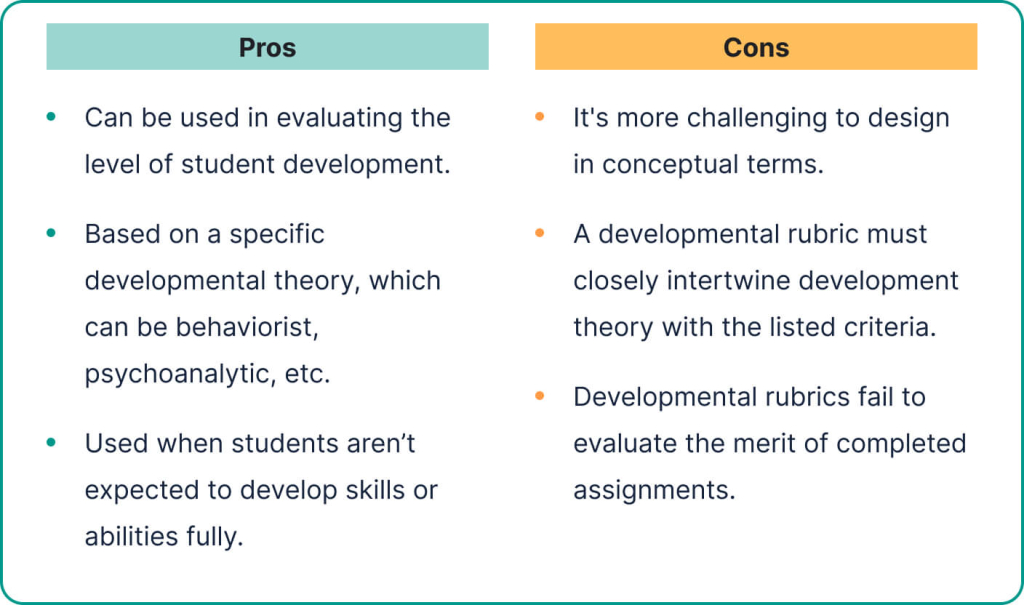
Example of a Developmental Rubric for a Personal Project
Task-Specific Rubric
This is one of the most precise rubric types. With its help, educators can provide detailed descriptions for each criterion. The task-specific rubric leaves no room for interpretation. Each assignment has strict guidelines for students. Educators and their pupils alike can use this rubric to quickly assess the quality of their work.
For example, teachers can use it to make thorough guidelines for term papers or essays. Each task-specific rubric will contain a description for each part of the assignment. These include the title, requirements for the thesis statement, paragraphs, and conclusion. It can be as detailed as the professor wants.
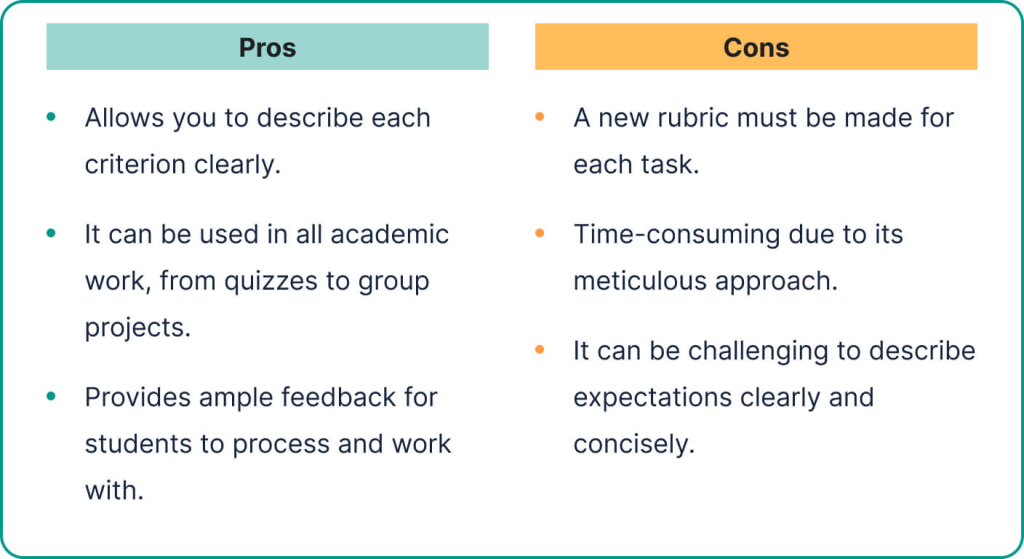
Example of a Task-Specific Rubric for an Opinion Essay
Analytic Rubric
This approach looks like a grid with student criteria placed in the leftmost column. Performance levels are placed in the top row. They are often measured with descriptive tags or a numerical system. Cells at the center may contain descriptions of specific criteria for each performance level. In the analytic approach, each criterion gets its own score.
This method allows you to connect guidelines with their assessment in a clear-cut manner. Students can even make analytical rubrics to evaluate their own work. This framework can show your progress over a specific timeframe, too. It’s a great way to assess your mastery of various skills.
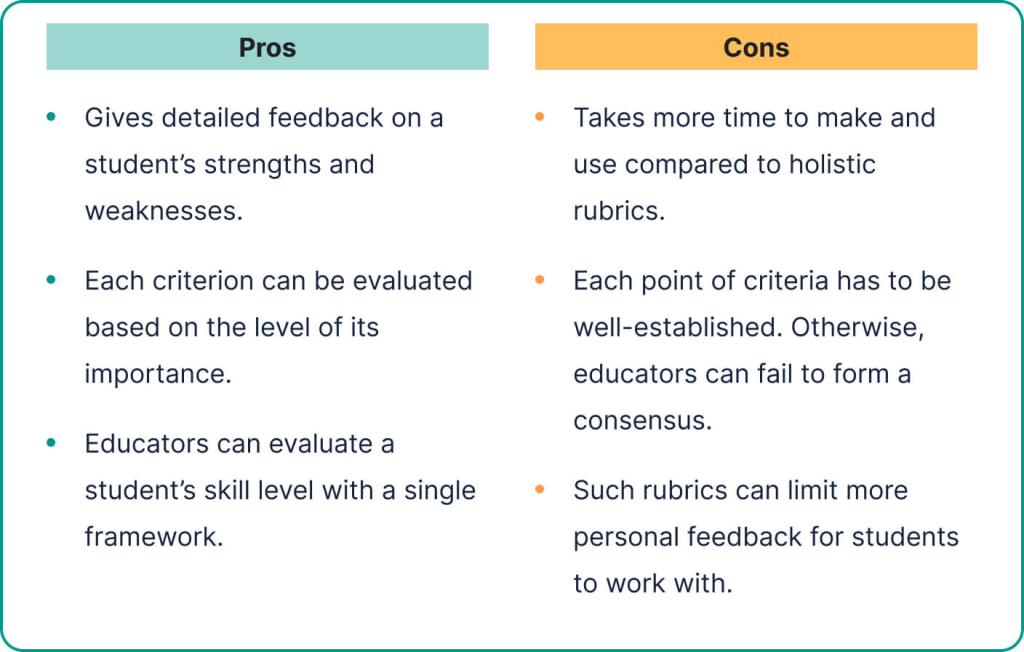
Example of an Analytic Rubric for an Oral Presentation
Holistic Rubric
This rubric is less complex than its analytical counterpart. With its help, educators don’t need to assess each criterion individually. Instead, they can evaluate the parameters as a whole. For example, when looking at an essay on Ernest Hemingway, teachers won’t need to evaluate its arguments or thesis statement separately. Rather, they may just focus on the coherency of the whole work.
In this approach, we use a single scale to score assignments. Usually, professors rate works on a scale from 1 to 4 or 1 to 6. Students are left with one long description of their tasks. Unfortunately, this can lead to misunderstanding or misinterpreting what is required of them, especially considering that most rubric criteria are concise in their nature.

Example of a Holistic Rubric for an Expository Essay
General Rubric
A general rubric is an assessment tool for evaluating performance, understanding, or proficiency in common and broad topics. We can customize that rubric for any task or assignment to fit its specific requirements. The grading ranges from less to more, or from “not meeting expectations” to “exceeding expectations.”
Also, such rubrics can help students better understand the aim of the task and receive constructive feedback. For example, if you need to write a research paper, you can create a general rubric to specify the acceptable and unacceptable criteria for performance. These can be related to writing style, grammar, the scope of research, etc.
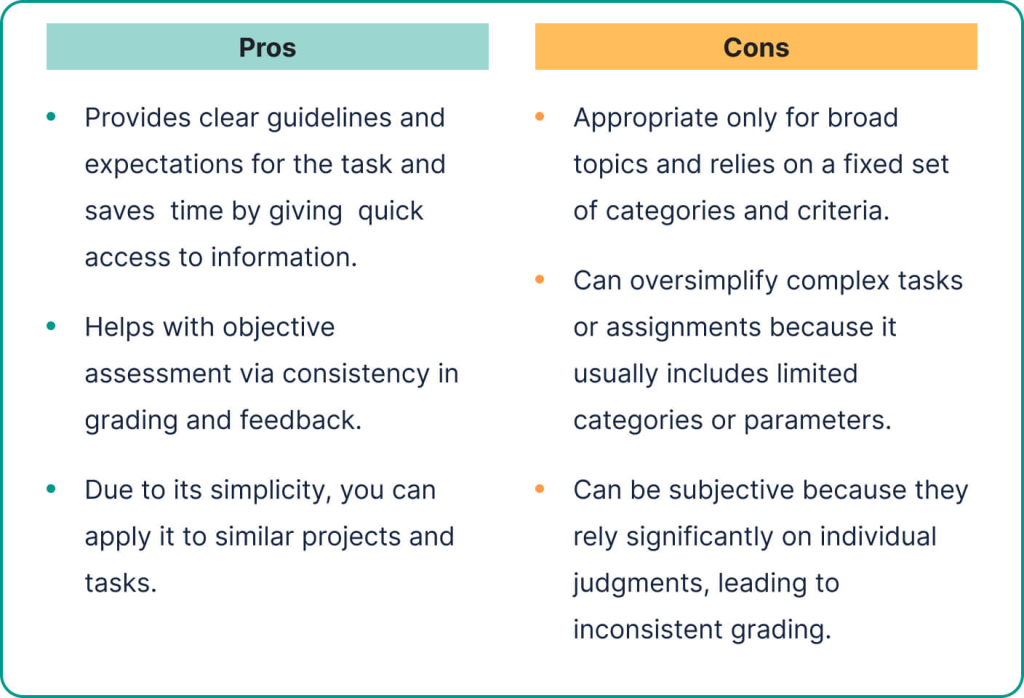
Example of a General Rubric for an Analytical Essay
Single-Point Rubric
A single-point rubric is a type of evaluation tool that educators use to assess student work based on a specific set of criteria or learning objectives. It has similarities to the analytical rubric. The expectations of the assignment are always defined separately and broken down into individual components.
For example, you might place the criteria or learning objectives of this rubric in the middle of the table. On the left, you note the points that should be improved, and on the right, the advantages of the work. Due to the feedback on each criterion or learning goal, such a rubric clarifies where you excelled and where you have shortcomings.
Single-point rubrics can be used for various tasks, including written assignments, projects, presentations, etc. They are designed to be flexible and can be adapted to different subjects or learning purposes. In addition, these rubrics will be useful for developing self-reflection and self-assessment sheets, so you can conduct individual evaluations and improve yourself.

Example of a Single-Point Rubric for a Literary Analysis
Checklist Rubric
A type of assessment tool that lists specific steps or requirements that you have to complete is called a checklist rubric. It’s designed to show whether you have understood a skill or concept. The idea is that instead of assigning grades to the various categories, the educator simply marks each item on the list as the task is finished. The marks may look like the following:
- Pass/Fail.
- Yes/No.
- Present/Absent.
- Checkmark/Cross.
It’s a great system for assignments with clear and specific steps, like science experiments or research papers.
Such rubrics can be helpful for several reasons. First, they provide a clear and specific set of expectations, which can help reduce confusion or misunderstanding. Second, they can be a time-saving evaluation tool because they require simply marking off each completed item rather than evaluating each category in detail. Finally, you can use it for self-assessment because the checklist results evaluate your work and identify improvement areas.

Example of a Check-List Rubric for an Informative Essay
Rating Scale Rubric
A rating scale rubric is a type of assessment tool that uses scaling to rate or evaluate student performance on an assignment. It breaks an assignment down into specific criteria or parameters, such as organization, clarity, or accuracy. It allows you to give a numerical or descriptive rating for each aspect of the task performed. This rubric suits assignments with multiple aspects or objectives, such as group projects.
It’s essential to use clear descriptions of the criteria. In general, rubrics with a rating scale provide a flexible and detailed approach to grading student work, allowing for a nuanced assessment of several aspects or criteria. They can help give specific feedback to students and promote particular learning goals.
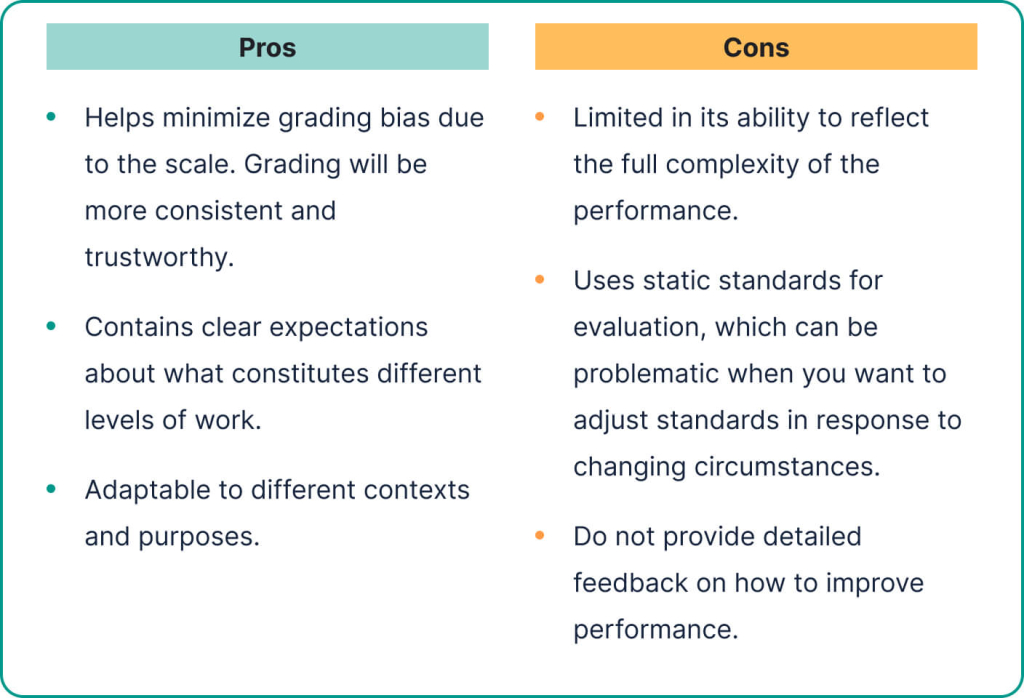
Example of a Rating Scale Rubric for a Group Project
💡 How to Develop an Effective Rubric?
In this section, we’ll share some of our best tips so you can learn exactly where to start and how to develop an effective rubric. Also, you can check out rubric examples to get a better idea of what it looks like. Keep reading, and you’ll find out how to write your rubric concisely and effortlessly.
- Establish the Learning Objectives.
Start by defining specific learning goals for the assignment for which you’re creating the rubric. To do this, you need to break down your task to keep your aims straightforward. This will help you identify the core criteria for your assessment and expectations. It may provide consistency in your targets.
Also, based on your goals and type of assignment, you can choose the rubric type that works best for you. This will ensure you can objectively evaluate your work. For example, the general rubric is the best if your goal is to have a broad view of the topic. However, you should select the analytic rubric for more in-depth and detailed knowledge. - Define the Criteria and Descriptors.
Before you can proceed with the creation of the rubric, you should identify the specific step-by-step results you expect. To do this, you need to develop key criteria for learning. These will form the basis of the rubric and set the assessment levels. Depending on the topic, you can make the criteria numerical or descriptive and then prioritize them. You can also combine similar points into one step or eliminate unnecessary steps not to complicate the assessment.
Next, you write descriptions for each criterion to ensure proper completion. The descriptions should include information about what you’ll learn by completing the specific item, effective ways to demonstrate what you’ve learned, and which steps to follow. Avoid using subjective evaluation measures or vague instructions, such as: “You must answer the question in an interesting way.” - Determine the Evaluation Method.
You should have at least three assessment levels for each criterion for an adequate assessment. The more variable the scale, the more motivation to improve skills and results. If the numerical estimation is well-formatted, then the format of the descriptive evaluation may look like this: “exceeds the standard,” “meets the standard,” “close to the standard,” and “below the standard.”
The rubric should be coordinated with the assignment or necessary activity for the task to be objectively rated. The criteria should reflect the assignment’s aims and the skills or knowledge expected for successful completion. Determine the value of each criterion in terms of an overall score. This will ensure that the rubric is balanced and that all points are appropriately valued. - Review and Refine the Rubric.
Once you have drafted your rubric, review and refine it. Make sure it’s straightforward, brief, and accurately reflects the learning outcomes and the purpose of the assessment. It would be worthwhile to get feedback on it. Share the rubric with professors or other students for feedback. They can give suggestions for improvements and point out areas that are unclear and need explanation. - Complete the Rubric Objectives.
Before using the rubric, test it to be sure it’s realistic. You can pick a simple topic and check how you handled it to save time. Alternatively, you may test it with a small group to ensure the rubric works as planned and to correct its possible shortcomings. This practice will help you to develop the skill of structuring rubrics with consistency and evaluating tasks with fairness.
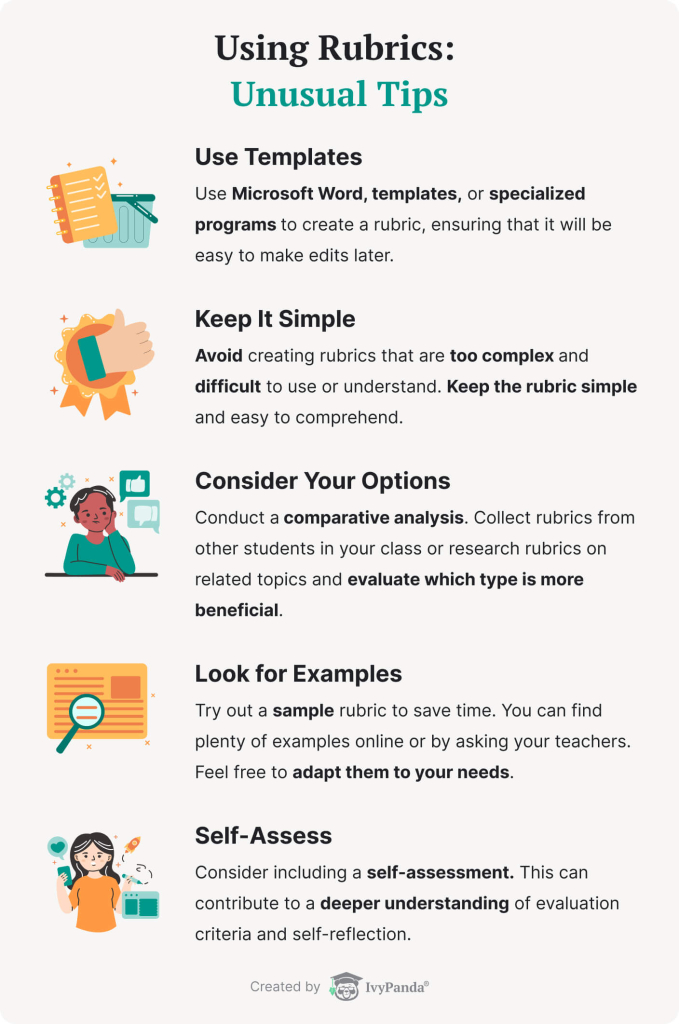
Thank you for reading our article! We hope this approach will help improve your learning process. If you have friends who are also interested in rubrics or who prefer to systematically structure their assignments, send them our link!
📎 References
- How to Use Rubrics. – Teaching + Learning Lab
- How Do Rubrics Help? – Edutopia, George Lucas Educational Foundation
- Types of Rubrics. – DePaul University
- 6 Tips on How to Make the Best Rubric. – Nick Gehl, The Art of Education University
- Rubric Best Practices, Examples, and Templates. – NC State University
- Guidelines for Developing Rubrics. – The Hong Kong Polytechnic University
- Rubrics for Assessment. – Northern Illinois University
- Principles of Rubrics and Grading Forms. – University of Sussex



